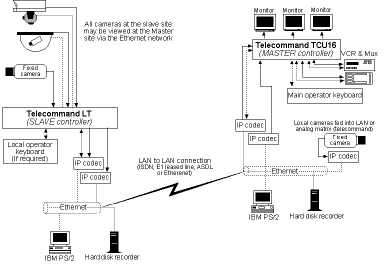
A typical surveillance system that relies on video images as part of the security process requires high quality realtime images. The reasons for this are simple - quality of image is needed for identification of suspects and the realtime element enables accurate tracking of a suspect through a crowd.
This requirement sets the benchmark for performance and operator-camera response times. Up until now digital technology has fallen seriously short of the mark in meeting these criteria.
Digital video codecs, IP networks and their integration in a security environment
Digital video codecs are available in many varieties offering varying performances at different bit rates. The choice of coding/compression engine and bit rate is driven by the application. For example, in the rail industry, it is imperative that pictures received in a control centre are guaranteed to be faithful representations of the source material to enable decisions to be made as to the opening or closing of crossing gates. It is typical to use M-JPEG compression at E1 (2,048 Mbps) to deliver the necessary quality on service. However, for remote site surveillance in the business sector, conditional refresh H261 ISDN codecs provide adequate performance. It is these different requirements that drive the users' decisions.
Why IP?
The term 'IP' stands for Internet Protocol. It is the universal protocol used within Ethernet networks worldwide. All modern PCs have 'IP' software as standard. As a result, it is common to find Ethernet networks in surveillance control rooms to support graphical use interfaces, diagnostic software and database management. Therefore, the decision to use IP-based digital codecs for digital video integration is a natural one. The challenge is in delivering the quality and response time for the user, and whether this is achievable at the right cost.
The application requirement
For many surveillance applications video information must be processed once it reaches the control room, with the typical scenario being the need to record, archive and recover video images for legal use. In addition, there is a growing need to use these images as 'stills' or 'clips' within reports and databases either locally or remotely from the control centre. The natural advantage of networking digital video is self-evident here. The key is to deliver sufficiently high quality at a low enough bit rate for all recipients.
Another area where video over IP has a role to play is in remote access applications. A typical example is a business premises. Here, video may not be required on a continuous basis. The event is driven by an alarm or passenger request and large distances are often involved. It is common for these types of applications that a LAN or WAN exists in the site. If video over IP codec technology is employed, the existing network can be used to transport the images and control data to a convenient location for site surveillance and for further transmission if required.
Finally, network capacity is a key component in the design equation, and must be carefully taken into account. Existing usage, expansion requirements and video picture performance criteria must be clearly defined.

Example application: remote site surveillance
Figure 1 shows a typical application where a remote site is linked into a master control centre. Normally the linkage between the remote and master sites would be effected using dedicated video and data feeds.
COE supplies fibre-based products for such applications based on analog technology for ultimate picture performance; however, these are not always applicable or cost-effective. In this example, the Ethernet network solves this problem. The example could represent a large industrial site or metropolitan area where a LAN/WAN already exists.
There are several key features to note:
* Cameras linked into the Ethernet network directly have their own unique IP address, and may therefore be viewed directly on a PC or decoded for inclusion in the existing master matrix.
* This hybrid approach suits new and existing installations and existing equipment is not made redundant.
* The master has full control of all cameras at the slave location.
* The use of a slave control unit allows manned or unmanned operation at the slave location.
* Cameras may be linked into the controllers by copper, fibre or Ethernet 10Base-T connections.
* Video performance may be set per camera by the PC control software.
* Video may be decoded for viewing on standard analog PAL monitors if required.
* Telecommand handles all the CCTV network administration, thus eliminating any special training for the installer or operator.
What sort of performance can be expected?
The H261 compression algorithm is suited to low-to-medium bandwidth applications and is typically found in video conferencing systems. Here, however, it has been carefully optimised for CCTV performance. The design criteria allows resolution, bit rate and frame rate control to be altered depending upon the application requirement. A maximum bit rate can be set in the codec to stop bandwidth overrun in heavily loaded networks.
The decoder produces a full screen image for viewing on a standard PAL monitor or for feeding directly to an existing analog video matrix. If viewed on a PC, the power of the PC will dictate the performance of the viewed image. Simple software routines can be utilised to allow rapid selection of cameras on the network either manually or automatically.
An operator's perception of delay when using joystick control is critical in any surveillance system, and it is here that most attention has been paid. The codec system has been optimised to reduce and manage this delay to allow continuous pan, tilt and zoom operation (which is not normally found in H261 codecs).
As digital technology advances, end-users can expect far more flexible solutions to become available. Video over IP will be driven hard by parallel markets therefore making it the most popular method of delivery for video. Users can therefore expect quality to improve.

© Technews Publishing (Pty) Ltd. | All Rights Reserved.